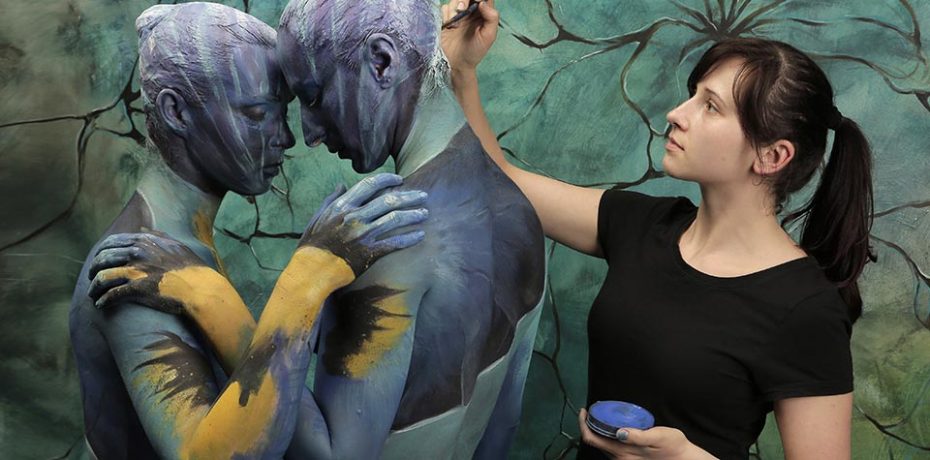History and modern time of bodypainting

History and modern time of bodypainting
Instinct, communication, beauty
Bodypainting is not widely known chapter of modern art. In my work I try to present historical concepts of bodypainting, its continuation in public life and beauty of modern bodypainting.
My thesis consists of three parts. In the first part I focused on origins of bodypainting, in the second part I refer to modern bodypainting realizations and body art searching for their differences, the third part is an attempt to answer the question: how important is makeup for people and what its role in people’s life is.
(…) Bodypainting derives from experiences from different generations, cultures and religions, and thus from nature. In each case where bodypainting appears, physical aspect and psyche confrontation takes place. It happens through discovering coexistence of human and nature. First step is to discover sensitivity to nature’s beauty, what precedes direct physical and psychical transformation.
Bodypainting is a psychical experiment, where you discover earth scent, wind gusts, stone hardness what means one’s own, primal belonging to nature. It’s like coming back to health, wild nature, being different and yet being you (Tradition and contemporaneity of bodypainting. Instinct, communication, beauty, page 45) (…) The most important function which can be associated with body makeup is esthetic one. It owes its rank to esthetic and plastic instinct. Human always wanted to look attractive, so makeup on the skin appeared regardless gender and age. Esthetics is one of many values, because when we try to define body art at the end of XX century, we discover that it co-creates ‘phenomenon of separate kind – traditional, philosophical as well as fashion trends or lifestyle’ (Gabriela Balcerzakowa, Auto creation. Format, 1999, 2-3, page 14). It includes other functions to some kind of a game and builds parameters, which can describe body makeup domain ( Tradition and contemporaneity of bodypainting. Instinct, communication, beauty, page 50). From eons dance consolidated bodypainting. Makeup became secondary yet necessary element of human expression and evolved itself together with changing concept of movement expression in many cultures.
In dance, where movement is the most important element, almost all human ways of expression can be found (Por. Jan Rey, Dance, its development and forms. PIW, Warszawa, 1958, page 23) At the same time movements being conductors of such emotions (joy, happiness, sadness, anger, etc.) have a beginning in instincts. This is why we know why makeup and dance coexist in accordance in traditional tribal traditions. They are born from obsession of imitating nature and instincts.
But not only dance animates body. A Person with painted face or in a mask doesn’t have to hear music to get into role assigned by makeup or mask. Imagining movement and expressing it with body has similar effect as movement of body to the rhythm of music. Such form of expression incorporated pantomime.
Sometimes it happens that the best way to show painted body is lack of movement. No movement (pose, posture) apparently insignificant and not worthy of using is perfect in some body painting realizations, inspired by camo and mimicry. For artists it is a kind of a play with a viewer, who watches painted background colors and still human body and is not always sure of what they see. Play lasts until first model movement, which reveals their existence.
Dance, movement or gestures are crucial in context of bodypainting. Common roots and codependency were noticed by Agnieszka Glińska, who created modern dance group Art Color Ballet, where dancers are passionate about dance and they paint their bodies for the shows.
In case of Art Color Ballet movement forces makeup, that needs to be visible on stage. Firm, bright colors, contrasts and linear patterns together with scenography create living form of art.
Group does not use only one style or tradition but derives inspirations from cultures of the world, creating synthesis of many styles of painting, dance and music. Art of bodypainting and dance signify past. They testify of beginning of artistic initiations in rituals. Nowadays, bodypainting is not connected with rituals but experiencing it bring people closer to the roots of art creation, original archetypes and shows. Maybe it is connected with searching for meaning of creation, what was found already by the tribal creators This is where inspiration comes from; using colors, composition, graphic symbols and symbosl used for centuries by tribal cultures of Africa, Polnesia and albo in traditions of the Native Americans and people from Orient.
(Tradition and contemporaneity of bodypainting. Instinct, communication, beauty. (page 48-49).
Exerpt from the thesis of Joanna Cieśla written under guidance of dr Rafał Solewski ART EDUCATION Kraków 2004